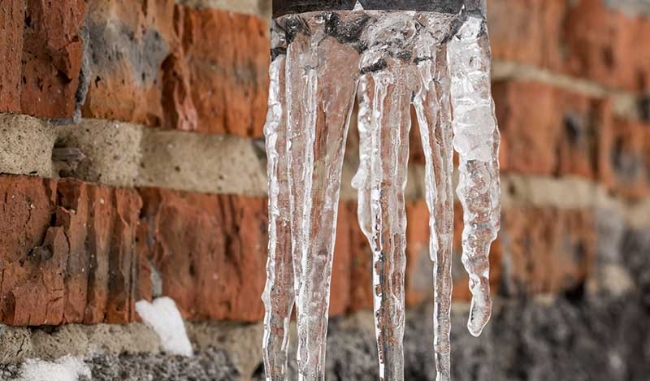Tips to Keep Pipes from Cold Weather Damage: Important Guidance
Tips to Keep Pipes from Cold Weather Damage: Important Guidance
Blog Article
This post listed below pertaining to How to prepare your home plumbing for winter weather is incredibly intriguing. Try it and draw your own findings.

Cold weather can damage your plumbing, particularly by freezing pipes. Here's exactly how to stop it from taking place and what to do if it does.
Intro
As temperatures decrease, the risk of frozen pipes increases, possibly bring about expensive repair work and water damage. Understanding just how to stop icy pipelines is important for house owners in chilly environments.
Avoidance Tips
Insulating vulnerable pipes
Wrap pipes in insulation sleeves or make use of warmth tape to safeguard them from freezing temperature levels. Focus on pipelines in unheated or external areas of the home.
Home heating methods
Maintain indoor areas properly heated up, particularly locations with pipes. Open closet doors to allow warm air to circulate around pipelines under sinks.
How to determine frozen pipes
Look for lowered water circulation from taps, unusual odors or sounds from pipes, and noticeable frost on subjected pipes.
Long-Term Solutions
Structural modifications
Take into consideration rerouting pipelines away from outside walls or unheated areas. Include additional insulation to attic rooms, basements, and crawl spaces.
Updating insulation
Purchase high-quality insulation for pipelines, attics, and wall surfaces. Appropriate insulation aids keep regular temperature levels and lowers the risk of frozen pipelines.
Securing Outdoor Plumbing
Garden hoses and outside taps
Separate and drain pipes garden tubes prior to winter season. Install frost-proof faucets or cover exterior taps with insulated caps.
Recognizing Frozen Pipes
What triggers pipes to ice up?
Pipelines freeze when exposed to temperature levels listed below 32 ° F (0 ° C) for extended periods. As water inside the pipelines ices up, it increases, taxing the pipe walls and potentially triggering them to break.
Threats and problems
Icy pipelines can result in water supply interruptions, residential property damages, and pricey repairs. Ruptured pipes can flooding homes and cause extensive structural damages.
Indicators of Frozen Pipes
Identifying icy pipelines early can avoid them from breaking.
What to Do If Your Pipelines Freeze
Immediate actions to take
If you presume icy pipelines, maintain taps open to relieve pressure as the ice melts. Use a hairdryer or towels taken in warm water to thaw pipelines gradually.
Conclusion
Protecting against frozen pipes requires proactive measures and fast reactions. By understanding the causes, indications, and preventive measures, home owners can shield their pipes throughout cold weather.
6 Proven Ways to Prevent Frozen Pipes and Protect Your Home
Disconnect and Drain Garden Hoses
Before winter arrives, start by disconnecting your garden hoses and draining any remaining water. Close the shut-off valves that supply outdoor hose bibs and leave the outdoor faucet open to allow any residual water to drain. For extra protection, consider using faucet covers throughout the colder months. It’s also important to drain water from any sprinkler supply lines following the manufacturer’s directions.
Insulate Exposed Pipes
Insulating your pipes is an effective way to prevent freezing. Pipe insulation is readily available at home improvement stores and is relatively inexpensive. Pay close attention to pipes in unheated areas such as the attic, basement, crawl spaces, or garage. Apply foam insulation generously to create a buffer against the cold. You can also wrap your pipes in heat tape or thermostat-controlled heat cables for added warmth.
Seal Air Leaks
Inspect your home for any cracks or openings that could let in cold air. Seal any holes around the piping in interior or exterior walls, as well as the sill plates where your home rests on its foundation. Additionally, make sure to keep your garage door closed unless you’re entering or exiting. Leaving it open creates a significant air leak that can lead to frozen pipes.
Allow Warm Air Circulation
During cold snaps, it’s essential to allow warm air to circulate evenly throughout your home. Leave interior doors ajar to promote better airflow. Open kitchen and bathroom cabinets to help distribute heat consistently around the rooms. If you have small children or pets, be sure to remove any household chemicals or potentially harmful cleaners from open cabinets for safety.
Let Faucets Drip
A small trickle of water can make a big difference in preventing ice formation inside your pipes. When temperatures drop significantly, start a drip of water from all faucets served by exposed pipes. This continuous flow helps prevent the water from freezing. Additionally, running a few faucets slightly can relieve pressure inside the pipes, reducing the chances of a rupture if the water inside does freeze.
https://choateshvac.com/6-proven-ways-to-prevent-frozen-pipes-and-protect-your-home/

We were shown that editorial on Helpful Tips to Prevent Frozen Pipes this Winter from a good friend on another domain. Sharing is caring. You just don't know, you may be helping someone out. We value reading our article about How To Avoid Freezing Pipes.
Call Today Report this page